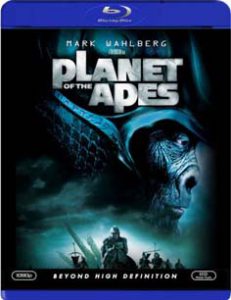This series celebrates 50 years of the “Planet of the Apes” film franchise. Here, we look back at director Tim Burton’s re-imagining of the material for his 2001 film.
Screenwriters William Broyles Jr., Lawrence Konner and Mark Rosenthal shake out the puzzle pieces of the 1968 “Planet of the Apes” screenplay and Pierre Boulle’s 1963 novel and reassemble them in a fresh fashion for uber-director Tim Burton’s “Planet of the Apes” (2001), which is loved by some and loathed by many, but certainly provides lots of things to talk about.
This version uses the idea of a planet with humans on one side and intelligent apes on the other to examine slavery, classism, subjective prejudices and the notion that political systems usually reward cruelty with power. It’s a sharp, if blunt, movie on those grounds. Meanwhile, the makeup effects are outstanding, allowing actors such as Tom Roth, Helena Bonham Carter and Paul Giamatti to go ape with their performances. The score by Danny Elfman is lush, fitting with the thick forests and homey ape villages.
If this had been the first adaptation of Boulle’s book, I think it would’ve been more well-liked for all of the aforementioned reasons. Even as a reinvention, it has a lot to offer. But there is also something cold and straightforward and archetypal about it. I think Mark Wahlberg, as Capt. Leo Davidson (as with a lot of these characters, I didn’t know his name while watching the film), is aiming for an old-school sci-fi Everyman performance, but it seems like he’s going through the motions. Bonham Carter gives the best performance as Ari, the chimp who is sympathetic to humans’ plight because she sees something in Leo’s eyes, and there’s an understated love triangle that also includes beautiful human Daena (Estella Warren).
At the end, Leo kisses them both, because that’s what old-school sci-fi heroes do; the fact that there’s nothing particularly weird about the human-chimp smooch is one of this film’s many items to chew over amid the theme of humanity’s obsession with superficial differences.
The 1968 film had the apes acting like a human society, moving like humans and wearing human clothing. But the 2001 film finds them acting like apes, except that they can speak and arrange themselves in a primitive societal structure. They have bedrooms, but they also have elaborate mating displays. The chimps swing among beams of structures, and the gorillas growl. None of this is considered “primitive”; it’s just normal.
Meanwhile, the humans live in forests, but they are intelligent and they speak. They are hunted by apes, who use them for experiments and as slaves and pets. They are in this subjugated position because they are losing the war against the apes that has gone on since the beginning of time as both species know it. Leo’s arrival in a space pod swings this grand conflict not because he’s more intelligent than the other humans (as was the case with Charlton Heston’s character in the original film), but because he possesses and knows how to use advanced weaponry. The apes view Leo’s laser gun like the Marauders in “Ewoks: The Battle for Endor” view a spaceship’s power cell – as a terrifying, divine creation.

By the film’s end on the titular planet, apes and humans decide to co-exist peacefully, as Pericles, a chimp from Leo’s original expedition, finally makes it through the time warp light-show and lands. The apes think he’s the Second Coming of Semos. And since Pericles is friends with Leo, the apes are chastised as a society into embracing peace. It’s a tidy ending, no doubt, but a satisfying one.
But – cue record scratch – the movie isn’t over yet.
When Leo returns to Earth – traveling again through the unpredictable time-warp that previously sent him to the planet of the apes – he finds that General Thade (Roth) had in the meantime parlayed his newfound weapons and space-travel knowledge into cruel power: Apes now rule the Earth. So a happy ending on the ape planet becomes a tragic ending on Earth, and a viewer is left feeling empty; the film’s message seems to be that peaceful trade and coexistence is a temporary state, and that cruel warmongers – even if outnumbered by peace-lovers — will rise to power. It’s not an off-point ending; it’s just a harsh one for a viewer seeking escapism.
The ending was also confusing to some viewers back in the day, including me, as I wrote in “Time travel and other summer movie annoyances.” But I now understand that the time at which Leo arrives – whether present or future – is irrelevant. The only thing that matters is that the time-warp lightshow can send Thade – using spaceship technology reverse-engineered from the crashed ship on his planet — further back in time than Leo. If that’s the case, then Thade can rewrite Earth’s history, taking the place of Lincoln – ape warmonger instead of human warmonger. Really, that lightshow time-warp makes almost anything possible (although a traveler is somewhat at the mercy of its randomness). Thade just has to live long enough to take advantage of his planet’s reverse-engineered spaceships (which is a stretch, but one of many in the film).
That said, it is enjoyable to anticipate the late-film twists – something Burton’s film parlays from both Boulle and Rod Serling. Leo and his human allies trek across the Forbidden Land to the site of the supposed appearance of the apes’ God, Semos. In reality, this is the crash site of the ship of Leo’s Earth astronaut allies. They had been attempting to rescue him, and they did find the same planet, but the light show did not knock them thousands of years forward through time like it did Leo.
The ship had landed on a deserted planet and functioned as a Noah’s Arc: The Semos-led apes – made intelligent through human experimentation (something 2011’s “Rise of the Planet of the Apes” would explore further) – ultimately subjugate the humans. All of the apes and humans Leo encounters are descendants of the occupants of his ship.
I have to admit I enjoyed the revelations of how it all ties together. Before that, Burton’s “Apes” is never surprising, but it is fun in a “What if we did this instead of this?” exercise in restructuring the classic material without dishonoring it. Ultimately, it’s more academic than engrossing, but it’s a worthy entry in the franchise.

